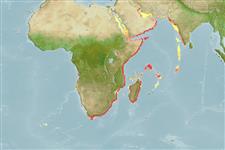Common names from other countries
>
Eupercaria/misc (Various families in series Eupercaria) >
Haemulidae (Grunts) > Haemulinae
Etymology: Pomadasys: Greek, poma, -atos = cover, operculum + Greek, dasys = with hair (Ref. 45335).
More on author: Lacepède.
Environment: milieu / climate zone / depth range / distribution range
Écologie
marin; saumâtre récifal; océanodrome (Ref. 51243); profondeur 0 - 49 m (Ref. 122701). Tropical; 31°N - 37°S, 18°E - 77°E
Southeast Atlantic and Western Indian Ocean: Western and Eastern Cape, South Africa, East Africa, Persian Gulf, Socotra, Seychelles, Madagascar to northwest coast of India.
Length at first maturity / Taille / Poids / Âge
Maturity: Lm 38.0 range ? - ? cm
Max length : 80.0 cm TL mâle / non sexé; (Ref. 2799)
Description synthétique
Clés d'identification | Morphologie | Morphométrie
Épines dorsales (Total) : 10 - 11; Rayons mous dorsaux (Total) : 14 - 15; Épines anales: 3; Rayons mous anaux: 9 - 10. Juveniles without spots on body (Ref. 2799).
Found in coastal waters, estuaries, and tidal fissures; can tolerate freshwater. It can jet a stream of water into the mud to expose crustaceans, worms and small bivalves which it feeds on (Ref. 11441); including fish (Ref. 5213). Tasty food fish (Ref. 2799). Maximum depth range from Ref. 122702.
Life cycle and mating behavior
Maturities | Reproduction | Spawnings | Egg(s) | Fecundities | Larves
Oviparous, distinct pairing during breeding (Ref. 205).
Smith, M.M. and R.J. McKay, 1986. Haemulidae. p. 564-571. In M.M. Smith and P.C. Heemstra (eds.) Smiths' sea fishes. Springer-Verlag, Berlin. (Ref. 2799)
Statut dans la liste rouge de l'IUCN (Ref. 130435)
CITES (Ref. 128078)
Not Evaluated
Menace pour l'homme
Harmless
Utilisations par l'homme
Pêcheries: commercial; pêche sportive: oui
Outils
Articles particuliers
Télécharger en XML
Sources Internet
Estimates based on models
Preferred temperature (Ref.
115969): 22 - 27.9, mean 26.8 (based on 146 cells).
Phylogenetic diversity index (Ref.
82804): PD
50 = 0.5000 [Uniqueness, from 0.5 = low to 2.0 = high].
Bayesian length-weight: a=0.01905 (0.01221 - 0.02973), b=2.95 (2.82 - 3.08), in cm Total Length, based on LWR estimates for this species & Genus-body shape (Ref.
93245).
Niveau trophique (Ref.
69278): 3.5 ±0.2 se; based on diet studies.
Résilience (Ref.
120179): Faible, temps minimum de doublement de population : 4,5 à 14 années (K=0.07-0.42).
Fishing Vulnerability (Ref.
59153): Low to moderate vulnerability (34 of 100).
